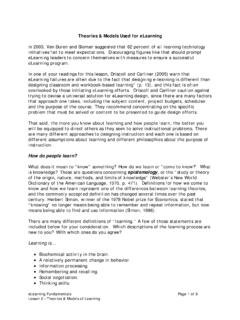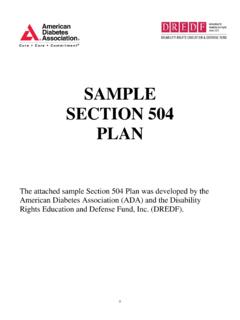Transcription of The Madeline Hunter Model of Mastery Learning
1 Dr. Madeline Hunter s research showed effective teachers have a methodology when planning and presenting a lesson. Hunter found that no matter what the teacher s style, grade level, subject matter, or economic background of the students a properly taught lesson contained eight elements that enhanced and maximized Learning . She labeled eight elements and began two decades of teacher training. The elements referred to as Lesson Design, Target Teaching, or Critical Teaching, have stood the test of time still used today in many teacher colleges and as reference for judging teacher effectiveness in many school districts. Within each element of Lesson Design, there are many sub-skills, methods, and techniques each demanding training, practice, and review in order to attain Mastery of the Hunter Model .
2 Simply knowing about or reading about Lesson Design will not produce flawless performance, but will form a basis for decision making. Basic Hunter Vocabulary (Each term has been defined using tow related statements) 1. Anticipatory Set The teacher focuses the students thoughts on to what will be learned (Tie in yesterday s lesson with today s lesson. Get them interested.) Anticipatory set is defined as a shot activity or prompt that focuses the students attention before the actual lesson begins. Uses when students enter the room or in a transition, anticipatory set might be a hand-out given to students at the door, review questions written on the board, two short problems presented on a transparency on the overhead, an agenda for the lesson written on the chalkboard, etc 2.
3 Objective and Purpose Students learn more effectively when they know what they are supposed to be Learning and why. Teachers also teach more effectively when they have the same information. (Tell what/how/why/the students are going to learn.) The purpose or objective of the lesson includes why students need to learn the objective, what they will be able to do once they have met the criterion, how they will demonstrate Learning as a The Madeline Hunter Model of Mastery Learning result. The formula for the behavioral objective is: The learner will do what + with what + how well? 3. Input The new knowledge, process or skill must be presented to the students in the most effective manner.
4 This could be through discovery, discussion, reading, listening, observing, etc. Input includes the vocabulary, skills and concepts the teacher will impart to the students, the information the students need to know in order to be successful. 4. Modeling It is important for the students to see what they are Learning . It helps them when the teacher demonstrates what is to be learned. The teacher shows a graphic or demonstrates in a concrete way exactly what the finished product looks like. Remember, a picture is worth a thousand words. 5. Checking for Understanding It is important to make sure the students understand what was presented. One way this can be done is by asking the students questions.
5 The teacher uses a variety of questioning strategies to determine Got it yet? and to reflect on the pace of the lesson: Should I move forward or back up? 6. Guided Practice The students practice the new Learning under direct teacher supervision. The teacher leads the students through the steps necessary to perform the skill using a trimodal approach: hear/see/so. 7. Independent Practice When the teacher is sure the students understand the new material, they assign independent practice. The teacher releases students to practice on their own based on Learning that has occurred during the previous steps. 8. Closure At the end of each lesson, the teacher reviews or wraps up the lesson by posing a question for the class: Tell me or show me what you have learned today.
6 Closure is not necessarily an end point, but more of a final check for understanding used at the end of a class period. Closure for on-going laboratory activities may not be appropriate. SUMMARY Teaching to an objective (lesson objective - not a step. ) 1. Objectives 2. Set [hook] 3. Standards/expectations 4. Teaching Input Modeling/demo Direction giving {see below} Checking for understanding 5. Guided Practice 6. Closure 7. Independent Practice Behavioral Objective format: Students will demonstrate their [knowledge, understanding, skill, etc.] of/to [concept, skill, etc.] by [activity performed to meet the lesson objective] according to [standard].
7 Example: Each student will demonstrate achievement of the skill of addition of whole numbers by adding columns of figures with paper and pencil accurately nine out of ten times individually in class. Four step instructional process 1. Watch how I do it [modeling] 2. You help me do it (or we do it together) [together] 3. I ll watch you do it or praise, prompt and leave [guided practice] 4. You do it alone [independent practice] Motivation TRICKS 1. Feeling Tone 2. Reward [extrinsic/intrinsic] 3. Interest 4. Level of Concern accountability time to produce visibility predictability 5. Knowledge of results 6. Success Ways of monitoring 1.
8 Oral individual 2. Oral together 3. Visual answers, , thumbs 4. Written 5. Task Performance 6. Group sampling Questioning Guidelines 1. Place signal [get their attention], then ask question 2. Ask question before designating the person to answer 3. Do not repeat nor rephrase the student s response. May ask for agreement by class or for others to respond. 4. Ask question then wait for 50% of hands [or bright eyes, knowing looks] 5. Never ask a question of a student who you know cannot answer. 6. If the student is confused or can t answer, calmly repeat the same question or give a direct clue. Retention, Reinforcement 1. Meaning/understanding (the most effective way to learn) 2.
9 Degree of original Learning . Learn it well the first time. {And don t practice it wrong!] 3. Feeling tone. [positive or negative will work but negative has some undesirable side effects.] 4. Transfer [emphasize similarities for positive transfer and differences where there might be an incorrect transfer.] [See Bloom s Taxonomy of Educational Objectives for levels of Learning . Transfer implies all of the higher levels. See Barak Rosenshine re. decontextualizing following this summary of the Hunter Model which is essential for effective transfer of knowledge and skills to the real world.] 5. Schedule of Practice. [Mass the practice at first, then create a regular follow-up schedule.}
10 ] Creating Directions 1. Break down into parts/steps. 2. Give only three at a time, one if the behavior is new. 3. Delay giving instructions until just before the activity. 4. Give directions in the correct sequence. 5. plan dignified help for those who don t tune in. [no put-downs] 6. Give directions visually as well as orally (Visual representation of the task) [cf. Fred Jones VIP] Giving Directions Give the planned directions [creation above]. Check the students understanding [ Any question? does not check understanding.] Have a student Model the behavior. [ , on the board or orally.] If needed, remediate and recheck. [It is essential that students do not practice error.


